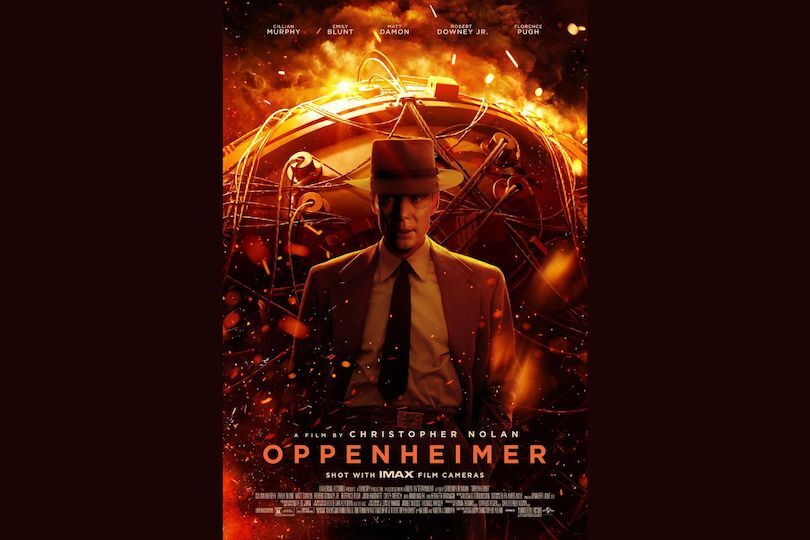Oppenheimer
Directed by Christopher Nolan
Common pictures2023
Christopher Nolan’s subtly crafted movie interpretation of Kai Chicken’s American Prometheus, gives a wealth of data for college kids of Worldwide Relations. The subject – the event of the atomic bomb – has been a chestnut of IR syllabuses for half a century. The ethical dilemmas and worldwide penalties of the bombings of Hiroshima and Nagasaki are a hotbed of each IR classroom dialogue. Furthermore, the world that adopted, with the worry of the Chilly Warfare and the specter of Mutually Assured Destruction (MAD), are recurring themes within the international educating of worldwide affairs. On this necessary movie, Nolan dissects the controversial legacy of Robert Oppenheimer (performed by Cillian Murphy), as ‘father of the atomic bomb’. In 1943, on the invitation of Normal Leslie Groves (performed by Matt Damon), Oppenheimer takes over the directorship of the Los Alamos Laboratory, the positioning of the Manhattan Mission in New Mexico, which is getting ready an atomic bomb. As Nolan exhibits, Oppenheimer was initially pushed by ethical issues. As for a way he overcame his preliminary dilemma, as a Jewish man he deeply feared the end result if the Nazis developed a weapon with such a deadly functionality. In doing so he overcame the preliminary ethical reluctance of the students, and little doubt the youthful Oppenheimer, like everybody else, was swept up by the frenzied tempo of historic occasions.
Nonetheless, after Hitler’s defeat, Oppenheimer nonetheless helped plant the bomb in Hiroshima and Nagasaki, now believing it could rapidly finish the horrific battle within the Pacific, and (naively) the idea of battle itself . As Nolan exhibits, the reluctant physicist turned to nuclear weapons. Now we all know that students have criticized the argument that the bombs hastened Japan’s give up. Some historians and IR consultants counsel that the actual turning level was the specter of a Soviet invasion. Actually, as this movie exhibits, Oppenheimer’s utopian imaginative and prescient was challenged by fellow scientists like Edward Teller (performed by Benny Safdie) and even by the chairman of the US Atomic Vitality Fee, Lewis Strauss (performed by Robert Downey Jr.) , which is an ever extra harmful H-bomb. Predictably, this was fully out of proportion to something the world had ever seen – a lot much less crucial. Deterrence had rapidly turn into a recreation of nuclear harmful energy. This crammed Oppenheimer with private anguish and remorse.
IR college students will then be capable of see how these international points performed out in opposition to the self-destruction of a superb scientist and the grotesque character assassination of his complete household circle. The massive searchlights of the American safety equipment rapidly beamed into the home of the silent scientist. Now Oppenheimer opposed the following nuclear arms race between the US and the Soviet Union. Predictably, he encountered the equally formidable weapon of American political oppression – specifically anti-communist hysteria. The Nice State went searching for Oppenheimer’s skeletons. Oppenheimer quickly fell sufferer to his private ties to the Communist Social gathering, via so-called ‘Commy camp followers’ equivalent to his brother Frank (performed by Dylan Arnold), spouse Kitty (performed by Emily Blunt) and ex-lover Jean Tatlock (performed by by Florence Pugh). There was an enormous safety file generated by state spies poking round within the scientists’ private lives. All this induced huge public humiliation for a personality vulnerable to psychosis and lifelong psychological well being issues.
IR instructors will marvel at how properly the movie is deftly constructed to assist the viewers perceive on an mental degree the breakthrough that led the protagonist to see himself because the ‘Loss of life, Destroyer of Worlds’ of the Hindu scriptures. It supplies glorious materials for sophistication dialogue of the ethical debate over nuclear weapons, because the movie superbly teases an unprecedented dialog between Oppenheimer and Albert Einstein (performed by Tom Conti). The explosion of the A-bomb, throughout its first check within the New Mexico desert, exudes the primal power that led Oppenheimer to see himself as a form of “American Prometheus” (as in Nolan’s 2005 biography). Nolan’s A-bomb is miraculous, reminding IR instructors that the atomic bomb was resolutely seen on the time as an achievement and never a nightmare. So, inside Oppenheimer. a person’s non-public, inside and political lives are overtly laid naked, every a luminous a part of the inherent contradiction that defines a person’s soul.
We additionally get a superb sense of IR historical past from this movie. Chronological timelines are processed visually via the usage of shade and black and white movies. We’re immersed within the Trinity Exams and the Second World Warfare via good shade, whereas the post-war period is in distinction archival black and white. A very powerful occasion is the Trinity nuclear check within the New Mexico desert in July 1945, when Oppenheimer is alleged to have mirrored (and later sung) on Vishnu’s strains from the Bhagavad-Gita: “Now I’ve turn into Loss of life, the destroyer of worlds”. Later within the Nineteen Fifties, the movie revisits him as a disillusioned, helpless official, hunted by the McCarthyites for his communist connections. We’re rapidly reminded that even essentially the most momentous occasions in international historical past are finally (of their creation) somebody’s painful non-public historical past. This in flip raises dilemmas for us as IR students, concerning the mutual territories of personal and public IR.
Maybe the movie’s pivotal second is its depiction of the legendary postwar assembly within the White Home Oval Workplace between Oppenheimer and President Harry Truman (performed by Gary Oldman), who made the chief choice to drop the bomb. Nolan and Murphy trace that the inventor is asking for absolution from the president, muttering that he seems like he has “blood on his palms.” Truman, in a reasonably priestly gesture, instantly takes full accountability as president and ponders: Does Oppenheimer suppose the Japanese care who made the bomb? As IR researchers, then, we see how non-public, inside, and political lives work together, as destruction and hubris gas a relentless logic (actually) of a sequence response.
French filmmaker François Truffaut argued that “battle movies, even pacifist ones, even one of the best ones, willingly or not, glorify battle and by some means make it enticing.” That is maybe why Nolan doesn’t present the bombings of Hiroshima and Nagasaki, in order that we as viewers are spared our personal dilemmas. We’re subtly transported from the phantasmagoric prowess of Oppenheimer’s physics to the belief that the Chilly Warfare actually started earlier than the Second World Warfare was over – it was at all times there, shaping the weird however ubiquitous paranoia of atomic bomb politics. We see Oppenheimer contraindicated because the ruthless nuclear fanatic and Oppenheimer as the paranormal idealist who merges. And we see that the race to finish the Manhattan Mission in Los Alamos, New Mexico, proved past doubt that the nuclear age had arrived. That is IR historical past offered in a single good tableau for dialogue.
Writing about Christopher Nolan Oppenheimer Thomas Gaulkin makes necessary revelations for the Bulletin of the Atomic Scientists. First, the historical past of the Bulletin is inextricably linked to the historical past of the making of the atomic bomb, not least as a result of Oppenheimer himself was the primary chairman of the Bulletin’s Sponsorship Board. Lots of the different main scientific figures depicted within the movie additionally served as early sponsors of the Bulletin (together with Albert Einstein and Edward Teller). His second revelation is that every inventor turns into much less and fewer necessary as time goes by. Nonetheless, by altering the world for the scientist, occasions take their very own energy and set their very own course in IR historical past.
OppenheimerWe should understand that the movie is Nolan’s prismatic psychological examine of 1 man’s human selections and struggles, and never a historical past of the bomb. To that extent, this movie can solely provide a private vignette. It’s only a sketch of the huge, ever-evolving topic of nuclear weapons in worldwide relations. It is only a cameo shot from a narrative that has its personal indefinite nuclear half-life and that possesses extra primal vitality than any human, even one as good as Oppenheimer. This can be a reminder of the bigger tapestry of up to date worldwide relations.
Learn extra about e-international relations


